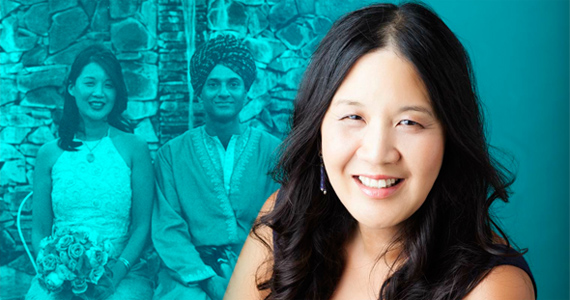
Alison Singh Gee ’86 knows her life sounds like a fairy tale – until you read the fine print.
Singh Gee was living in Hong Kong, an award-winning and self-described “it-girl” of journalism, but felt there was something profound missing in her life until she met Ajay, an Indian journalist.
“It was a moment of cellular recognition, when you realize that the person you were meant for was standing in front of you,” Singh Gee said of meeting her husband. And this was before she learned he grew up in a palace.
Speaking on Monday, April 1 at the Malott Lunch Lecture, Singh Gee read from her debut memoir Where the Peacocks Sing: A Palace, a Prince, and the Search for Home.
“When you see people leaning in, their eyes grow gigantic, and they say ‘You have to write about this,’ then you know you’re on to something,” she said of her choice to write when her own life had become a fairy tale.
It wasn’t until after they married that Singh Gee discovered the truth. She left her mother and Ajay sitting on the terrace of a restaurant and came back to find her mom ecstatic, exclaiming, “One hundred rooms, that’s an awfully big house!” Confused, he told her he had grown up in a small palace in India, of which they were to inherit the largest wing.
Singh Gee admits to picturing velvet day beds, French chandeliers, and servants waving gigantic peacock fans when she first heard this. However, the fantasy wasn’t quite as picturesque as the reality – a palace built in 1911 that remained without electricity and had hot water only after running an earsplitting generator for hours. When the family had money the outside was white-washed; when they didn’t, the walls fell into a state of disrepair. On her first visit, Singh Gee reached out to touch the wall and a part crumbled into her hand.
That’s not to mention the 70 hostile cousins and her mother-in-law living in the other wings.
“When I first envisioned the book, I thought each chapter could be a beautiful picture,” Singh Gee said. Instead, her memoir became a reflection of how she found a new family and a new home in the unconventional beauty of the palace.
Singh Gee credits Scripps College for teaching her how to appreciate beauty in the most unexpected of places. While wandering through Browning Hall during Camp Scripps in the summer of 2010, she saw into a room with campers with their feet propped up on the windowsill, looking into the courtyard. All of them, whether 85 or 22, were either writing or sketching or painting.
“I looked at them and thought, that’s me,” Singh Gee said. “That’s such a big part of what Scripps gave me: the love of beauty and the search for meaning in my everyday life.”
Now, Singh Gee swears there’s at least one alumna in the audience of almost every reading she does.
Her search for meaning will continue in her second book, a sequel to her memoir. For now, Singh Gee has a restored faith in the beauty of fate and a renewed understanding of what it means to be family.
“My father had been obsessed with magnificent houses and pieces of land,” she said. “My father’s own life had never quite taken flight… I had inherited his obsession with castles in the sky. Here was validation that my father and my own family deserved the castle of our dreams.
“It was proof we were actually fated to live in a castle after all.”

